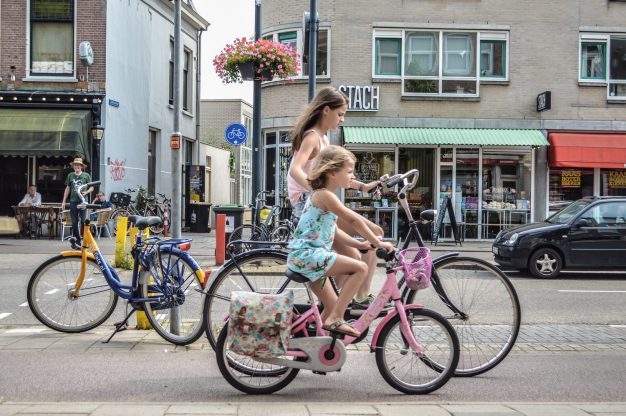
Child in the City World Conference Dublin 2022: Meet Anne Müller
We are delighted to be opening the doors today to our 10th Child in the City World Conference, being held in Dublin. One of the opening day contributors is Anne Müller, who will be talking about child and youth participation in Germany’s ‘child friendly municipalities’. Anne spoke to Child in the City.
Child in the City: Can you please outline your role, and also that of the specific department and/or organisation that you work for?
Anne Mueller: I’m working for the German programme and initiative ‘Kinderfreundliche Kommunen’. ‘Kinderfreundliche Kommunen’ supports cities and communities all over Germany to promote the implementation of the UN Convention on the Rights of the Child (UNCRC) at the municipal level. The programme is part of the international Child Friendly Cities initiative of UNICEF. As a consultant I support participating cities and communities on their path to becoming more child friendly.

CiTC: The theme of our conference in Dublin is ‘Making Connections’, and focuses on how we make connections between both children and cities, and the various disciplines and professionals. Can you summarise how this relates to the presentation you will be giving in Dublin?
AM: This year ‘Kinderfreundliche Kommunen’ is celebrating its 10-year anniversary. A milestone that gave us reason to commission an impact analysis. We wanted to take a look at the past and present to analyse changes regarding child-friendliness in our participating cities and communities. At the conference, I will present the results of this impact analysis with regards to child and youth participation: How has the participation of children and adolescents in planning and building projects changed? Which cohorts were reached particularly well? Which structures are necessary to secure participation processes? I will make a connection between the observed changes and our programme while at the same time naming success factors and obstacles on the way to child-friendliness.
CiTC: When city leaders and planners sit down to consider the future of their municipalities, are there any particular lessons which, in your opinion, can always be adopted and adapted in other cities?
AM: Children and families should be at the centre of sustainable city planning. The realization of children’s rights is an opportunity and a prerequisite for the future viability of cities and communities. In order to be more child-friendly, municipalities must strengthen the systematic participation of children and young people. At the same time, all municipalities should develop a concrete action plan to improve the living conditions of children and young people. Children and young people themselves as well as actors from civil society, local business and welfare institutions should be involved in its development, implementation and monitoring.
CiTC: As we stand here in the year 2022, do you think the notion of creating ‘child friendly cities’ now has enough momentum worldwide to ensure that soon the days of city planners automatically putting the vehicle ahead of the child (and the adult of course) will be gone for good?
AM: When municipalities join our program, we start by surveying the children who live there. Again and again, it can be observed that children take a critical view on the condition of cycle paths and footpaths. They say that if they were mayors, they would reduce traffic and improve sustainable means of transportation. However, participation of young people in traffic planning is not yet widely implemented.
Taking this into consideration, I think we still have some work ahead of us to ensure that children are put ahead of vehicles. At the same time, I’d like to take an optimistic stance: Planners, especially those of the younger generation, are very motivated to create cities and communities that focus on the wellbeing of all inhabitants – young and old. Global conferences like these help practitioners and academics alike to network and share ideas on how to create liveable, healthy and sustainable cities.
CiTC: In your view, do we, as a society, talk to and take seriously enough the views of children and young people as regards their ideas for creating specific facilities in cities that can improve their futures?
AM: ‘Kinderfreundliche Kommunen’ regards child and youth participation as a core element of child-friendliness. Our impact analysis showed that participating cities and communities improved their means of child and youth participation in many areas. Children and adolescents now have a say when it comes to the planning and creation of leisure facilities, playgrounds, greenspaces, and more. But unfortunately, recent events, such as the Corona pandemic, have also shown that children’s rights are often cast aside when crisis hits.
Young people suffered immensely and their views were often not considered: As a society, we talked about young people but not with them. However, especially in uncertain times, it is paramount to give children and adolescents a voice. In our daily work with cities and communities we observed the following: Cities and communities with representative forms of child and youth participation, such as children’s and youth councils, were generally more ‘crisis-proof’. They often managed to stay in contact with young people and have generally fared better in giving children and young people a voice in times of Corona.
CiTC: Finally, if you could have the audience in Dublin take away just one key message from your presentation, what would it be?
AM: Implementing child-friendliness in administration takes time and patience. But it can be done … and it’s worth it.
Anne Müller will be part of parallel session 2.1, Connecting children’s participation to urban policies, in the Poddle Room, Printworks Conference Centre, at Dublin Castle, from 1400-1530.




